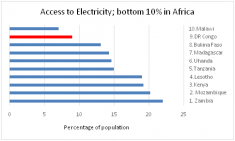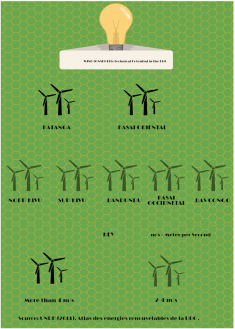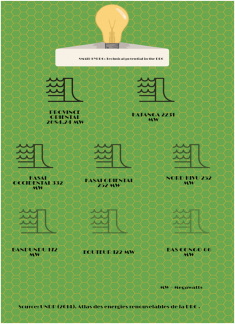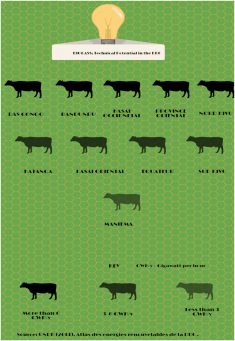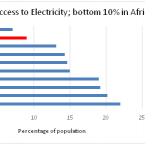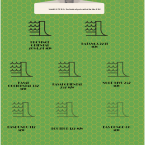Alternative Energy's Massive Potential in Congo
The Democratic Republic of Congo (DRC) is faced with a paradox.
The country possesses some of the largest hydropower potential in the world, yet since the 1950s, large hydro has supplied only 9% of DRC’s total population – just six million people out of 67.5 million – with access to electricity. These six million people, furthermore, receive electricity that is extensively rationed and unreliable. In spite of large hydro’s stagnant electrification trends within the country, the DRC’s government has plans to develop more large hydropower projects – in particular, through the ridiculously expensive Grand Inga, which will cost US $80 billion.
The good news, however, is that the DRC possesses much better and cheaper alternatives which could achieve what big hydro has not: The country has significant and largely unexploited solar (PV), wind (onshore), micro hydro, biogas and biomass potential. These renewable energy technologies have improved massively in recent years, and costs have come down substantially. Such technologies also offer socio-economic benefits that go beyond improved access to electricity, including increases in productivity, a better quality of life and environmental sustainability.
By exploiting its alternative renewables through on-, off- and mini-grid distribution, the DRC can ameliorate electrification trends within the country.
Exploring the DRC's Renewable Potential
In this regard, solar potential in the DRC lies on a scale of between 5.5 kWh (kilowatt hour); 5.5 to 5 kWh; and 4.5 to 3.5 kWh – enough to power two-bedroom houses in ten out of its 11 provinces. Wind velocity, on the other hand, is available in speeds between higher than 4m/s (meters per second) and 2 to 4 m/s in seven out of its 11 provinces. Such wind speeds have the potential to generate 15,000 kWh/year. The DRC’s 11 provinces have an average small hydropower potential of 722 MW (megawatts). Ideally, the exploitation of this potential through mini-grid distribution in rural DRC is enough to dramatically improve the 2% rural electrification rate.
The existing potential energy recovery from agricultural waste (biomass) in the DRC lies on three scales: more than 300 GWh/y (gigawatt hour per year); 300-700 GWh/y ; and less than 300 GWh/Y, in nine out of its 11 provinces. Once exploited, the electricity generated can power anywhere between 80,000 to 160,000 homes. In addition, biogas potential (energy recovery from animal waste) lies between greater than 6 GWh/y; 3-4 GWh/y; and less than 3 GWh/Y in ten out of its 11 provinces. This means that anywhere between 13,000 to 16,000 households in the provinces can be powered.
To exploit these alternative renewable power sources, the DRC's government should adopt a comprehensive renewable energy policy.
According to REN21, the DRC is one of the remaining eight African countries without a renewable energy policy or renewable targets. Initiatives in this regard in the DRC have solely been focused on large hydropower, overlooking less costly and more beneficial alternatives. Therefore, given the low electrification rates in the DRC, its low-income status and its human and economic development deficiencies, it's incumbent on the government of the DRC to avoid extreme public expenditures on unjustifiable large hydro projects such as the Grand Inga. Instead, it must adopt a renewable energy policy and create an enabling environment for the robust exploitation of renewables. This is how the country can fulfill sustainable development goal No. 7: affordable and clean energy.

